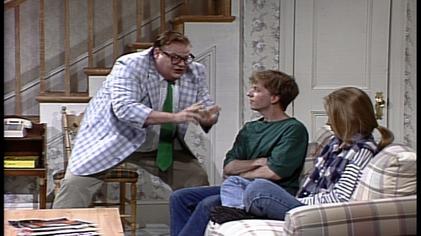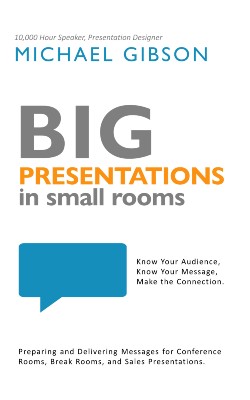Distracting Gestures Create Stress
The information is interesting and valuable. You want to focus and take it all in. But you are distracted.
“I feel uncomfortable. What is going on? This is weird. The gestures seem off. Why is that?”
Most of us have experienced the awkwardness created by distracting gestures. We are sitting in the audience wondering about the movements rather than listening to the message. The awkwardness was created because the gestures were either unnatural or inappropriate for the room.
You have hope and a presentation goal. You know your audience and have discovered the audience benefit. You organized the content and the visuals so that you can be a trustworthy presenter. You realize the importance of appropriate eye contact, and now it is time to focus on gestures—natural and appropriately-sized gestures.
Be Natural to Avoid Distracting Gestures
Be natural. This advice sounds too simplistic to some and too difficult to others. Gestures should flow naturally with the content and the tone. Unnatural movements are a common form of distracting gestures. They distract from your message and focus audience attention on the action rather than the content.
The mismatch may be due to a lack of preparation. The preparation included memorizing gestures that would match each concept. However, the practice was not intense enough to make those gestures effortless to make those gestures flow without thinking about them. You know this is happening when the motion comes just a half-second late. The word is said and then you can tell the speaker is remembering to pull up the appropriate gesture to support that point. The lag time creates a distracting gesture.
Another source of distraction may involve the personality of the speaker. Some people normally use awkward gestures. This situation can be challenging because you do want to be relatable and you do want to be yourself. However, you do not want to do things that would cause people to focus more on your awkwardness than on the content you provide. And if the change is too dramatic, people may be wondering what happened to you rather than considering the concepts you seek to communicate.
In the 1980 movie, Popeye, Shelley Duvall is brilliant as Olive Oyl. Her natural gestures are beautifully awkward. I remember the gestures more than the lines! I would often miss a line because I was mesmerized by the distracting gestures — the way she swayed as she spoke her lines. This is great in a comedy. It is not so great in a presentation.

Perhaps you have heard the old advice,
“Be yourself unless you are a jerk. In that case, be someone else.”
If your gestures are overly awkward, then perhaps you do need to adjust. Remember that the goal is for the audience to focus on the content. So use wisdom when considering changes to your gestures. It might be good to receive feedback from a trusted mentor familiar with the situation and the audience. They might be able to guide you to make appropriate and effective changes.
Fit the Room to Avoid Distracting Gestures
In May of 1993, Chris Farley, starred in a Saturday Night Live sketch that became one of the most popular comedy sketches of all time. Matt Foley: Van Down By The River is a classic. One element that made it so funny was the distracting gestures used by his character. Motivational speaker Matt Foley’s movements were too big for the setting. The furniture is not safe when he gets going!

On a smaller scale, this happens all the time!
“Oh no! I am so sorry! Let me help you clean up and get you another cup of coffee!”
Do you have a friend whose passion expresses itself in big gestures?
In a crowded coffee shop, they are an accident waiting to happen!
You can feel the tension of surrounding tables long before the mishap occurs. The gestures are too big for the environment, and it creates a distraction.
I have been that person. I have been the one using distracting gesturing in ways that were oversized for the situation.
The same thing can happen in presentations. It is good to be observant. Notice the room size and the space provided for the presentation.
If those spaces are small, contain your gestures to the area defined by your torso (shoulders, waist, sides). The bigger the room, the more you can expand. If you are in a large room with a big stage, use bigger gestures.
Distracting gestures that are too big for the room create the impression that you are insensitive and maybe a little out of control.
If you are slapping the screen or knocking over items on the stage, this might be you! Bring your gestures in so that you match the size of the room.
Distracting gestures that are too small for the room create the impression that you are timid and maybe lack confidence in your content.
If you keep all gestures close to the body even when on a big stage, this might be you. If your elbows seem glued to your sides and all motions are limited to wrist movements, this might be you. Expand your gestures, use your shoulders and elbow in ways that match the size of the room.
Appropriate gestures are like proper room temperatures. You don’t notice them unless they are creating discomfort. And then they become distracting gestures. Your movements should not be the presentation’s focus; they should be a natural part of the message. The content is the focus, and the gestures help maintain it.

Here is your homework. Pay attention to presentations. Notice how natural they are and whether the size fits the room. Think about the gestures and the size of gestures that you would use in different rooms where you deliver presentations.
Want to know more? Keep reading!
Want to know even more? Get the book, Big Presentations in Small Rooms!
So, what are some gesture stories you have experienced? Think of times of awkwardness, badly timed gestures, or gestures that were the wrong size for the room.




